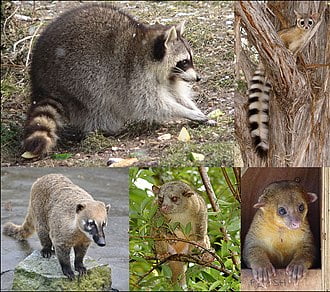Procyonidae

Procyonidae is a New World family of the order Carnivora.[2] It comprises the raccoons, ringtails, cacomistles, coatis, kinkajous, olingos, and olinguitos. Procyonids inhabit a wide range of environments and are generally omnivorous.
Procyonids are relatively small animals, with generally slender bodies and long tails, though the common raccoon tends to be bulky.
Because of their general build, the Procyonidae are often popularly viewed as smaller cousins of the bear family. This is apparent in their German names: a raccoon is called a Waschbär (washing bear, as it “washes” its food before eating), a coati is a Nasenbär (nose-bear), while a kinkajou is a Honigbär (honey-bear). Dutch follows suit, calling the animals wasbeer, neusbeer and rolstaartbeer respectively. However, it is now believed that procyonids are more closely related to mustelids than to bears.[3]
Due to their omnivorous diet, procyonids have lost some of the adaptations for flesh-eating found in their carnivorous relatives. While they do have carnassial teeth, these are poorly developed in most species, especially the raccoons.
Procyonid fossils once believed to belong to the genus Bassariscus, which includes the modern ringtail and cacomistle, have been identified from the Miocene epoch, around 20 million years (Ma) ago. It has been suggested that early procyonids were an offshoot of the canids that adapted to a more omnivorous diet.[4] The recent evolution of procyonids has been centered on Central America (where their diversity is greatest);[5] they invaded the formerly isolated South America as part of the Great American Interchange,[6] beginning about 7.3 Ma ago in the late Miocene, with the appearance there of Cyonasua.[7]
Genetic studies have shown that kinkajous are a sister group to all other extant procyonids; they split off about 22.6 Ma ago.[8] The clades leading to coatis and olingos on one hand, and to ringtails and raccoons on the other, separated about 17.7 Ma ago.[5] The divergence between olingos and coatis is estimated to have occurred about 10.2 Ma ago,[5] at about the same time that ringtails and raccoons parted ways.
